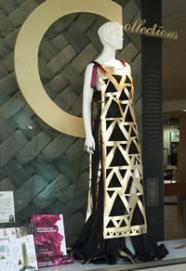Te Papa and Beyond - Ruby Hanfling
Asked to design wearable art on the theme 'Glitz and glamour', Ruby created a costume inspired by the work of artist Gustav Klimt. Her work was displayed in the main window of the Museum of New Zealand Te Papa Tongarewa as part of the annual World of Wearable Arts (WOW) events in Wellington.
Design
Ruby wanted her garment to reflect 1920s glamour. Her final design captured the look of that era while staying true to the recycling of materials valued by WOW®. Inspired by the work of Gustav Klimt, Ruby's design incorporated the Tree of Life which appears in his Beethoven Frieze.
A wrap-style underdress would be drawn in with a cord belt at the waist, to give a Grecian look. This style also has the advantage that it can easily fit on any mannequin, no matter what its leg placement. Ruby designed a tunic to go on top, with triangle-shaped cut-outs to reveal the decoration underneath. The bottom of the tunic would have a wavy look and a fishtail at the back.
Ruby later changed her design, deciding that the plain, classic look she had envisaged didn't look very interesting. She added gold side panels and notes that the contrast of the lacing with the plain black pin tucking was crucial in adding depth and interest to the garment.
Materials
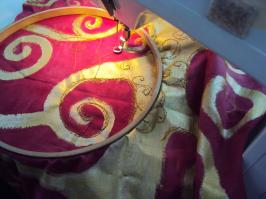
Ruby's gold foil design.
Innovation was one of Ruby's key specifications. She also needed materials that would give the glamorous effect she wanted and were free or recycled. She experimented with leftover chocolate wrappers and decided that gold foil would fit her design perfectly. Porirua confectionary firm Whittaker's agreed to provide her with a roll of foil left over from their production line. After an anxious wait due to a hold-up, she was thrilled to receive a big section of foil.
Ruby sewed samples of the foil, to check it would be durable enough to work with. She found that strengthening it with interfacing and calico, with added top stitching for extra strength, produced a unique textile. Ruby planned to use metallic thread, to add to the 'glitzy' look, but when she looked at materials found that this was too expensive to use in large quantities so substituted plain thread. She used pre-made cord to lace the costume, choosing black and gold to complement and stand out against the colours in the dress.
Trialling and testing
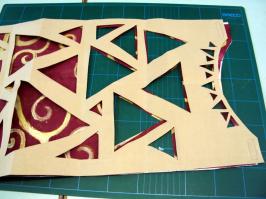
Ruby's trial sample.
Ruby tried machine-sketching for the first time and, after making samples, decided to use this technique for the bottom of the under-dress. She also made samples of stitching she would use on the main section of the dress. She had hoped that the stitching would show through the foil as indentations, but the thread wasn't thick enough to give this effect.
Ruby also trialled different methods for lacing up the side panels and considered the decorative effect she could create. She thought about incorporating large triangles on the side and having the lacing going over them, but decided that this ruined the simplicity of the design, "It became too complex and risked losing the polished look". Trialling these different ideas was important, Ruby says, to stretch her design and help her take it to the next level.
She tested several types of wire, looking at flexibility and strength. She needed a wire that was easy to manipulate yet strong enough the hold the curved shape of the hem – she hand-stitched the hem, rolling it around the wire.
Construction
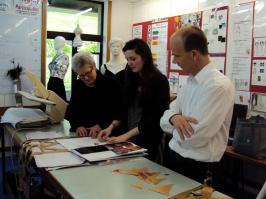
The construction process.
Sewing pin tucks into the under-dress was time-consuming. Ruby compiled a "pin tucking playlist" on her iPod – lots of 'beat' music to keep her going through six hours of pin tucking! She was pleased with the effect they gave the whole garment, although she had to consider other aspects related to the pin tucks. Because this technique uses much more fabric it made the garment very heavy, so she had to think about where to place straps and fasteners to prevent the costume from slipping when it was on display.
Because the pin tucks made the under-dress fabric quite thick, it meant that the seams didn't look as neat as Ruby liked. She decided to add a lining to the tunic, to give a smoother look to the whole costume. However, she adds, the pin tucks stuck up beautifully once they were pulled taut around the mannequin and added an extra dimension to the detailing.
Ruby painted her tree of life onto the under-side of the overdress, so that it showed through the triangle cut-outs. She drew and painted the design first, stitched embroidery over it and then cut the triangle shapes. Ruby used a relatively long stitch to attach the side panels, to minimise the number of needle punctures in the foil in case it weakened. She says that attaching the panels was quite hard, because of the weight of the pin tucked fabric, and that it caused a problem. After joining one panel, she found that it warped into a wavy look, due to the different widths of the two fabrics. Ruby says she was just "gutted" and planned to unpick the panel and make new ones. However, "The more I looked at it, the more I liked how unconventional and different it looked".
The weight of the pin tucked fabric proved too much when she added the fishtail, and the straps kept sliding down. Rather than use sticky tape, in case she damaged the mannequin, she hot-glued the strap that rested on the shoulder. Once this was dry, it was enough to prevent the straps from slipping.
Accessory
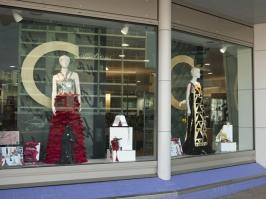
Ruby's design on display at Te Papa.
Asked by her client to create an accessory, Ruby made an elegant necklace based on triangle shapes to match the dress. The gold triangles were made from the foil and had red triangles on top to add more detailing. Ruby trialled different methods of stitching because she wanted the stitches to show through, but also wanted to present a neat finish. She hung the triangles from a red ribbon, to bring more colour to the costume. The work was completed with some rings, made from chocolate wrappers and glued on to elastic.
Outcome
Stakeholder feedback was overwhelmingly positive, and many visitors were surprised that the costume was created by a school student. Ruby's client commented that her garment was worthy of a place on any catwalk around the world. Ruby was awarded a New Zealand Scholarship in Technology for her efforts.

